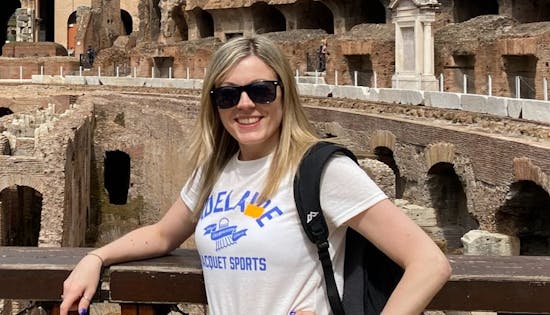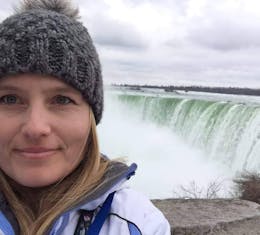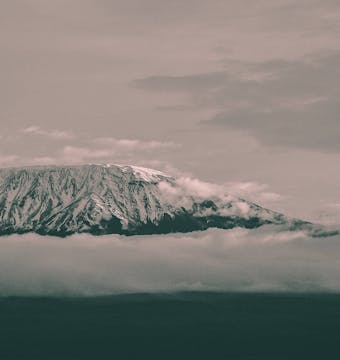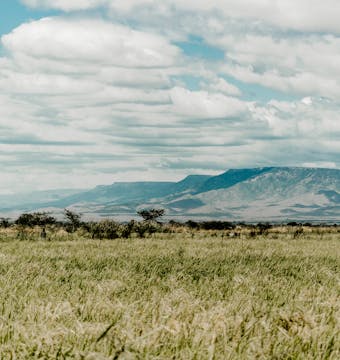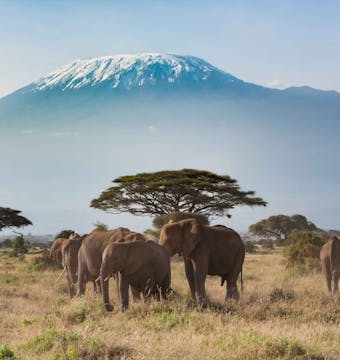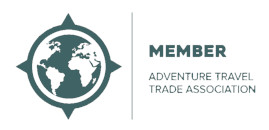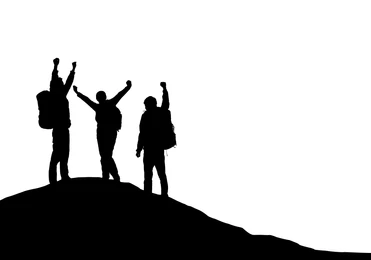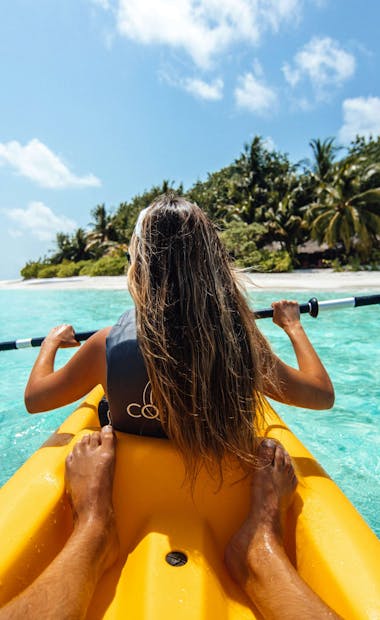Kilimanjaro Treks & Tours
Trek Kilimanjaro To The Summit!
Popular tours
- Save11%
 View Tour
View TourKilimanjaro Lemosho Hike - 10 Days
- Moshi to Moshi
- Age group: 12 - 99
- Max group size: 20
Was:£2,094From£1,864 - Save11%
 View Tour
View TourKilimanjaro - Machame Route - 8 Days
- Moshi to Moshi
- Age group: 18 - 99
- Max group size: 20
Was:£1,766From£1,571 - Save14%
 View Tour
View TourHike Kilimanjaro - Marangu Route - 6 Days
- Moshi to Moshi
- Age group: 18 - 99
- Max group size: 20
Was:£1,530From£1,315 - Save11%
 View Tour
View TourClimb Kilimanjaro - Machame Route - 7 Days
- Moshi to Moshi
- Age group: 18 - 99
- Max group size: 20
Was:£1,615From£1,438 - Save11%
 View Tour
View TourClimb Kilimanjaro: Rongai Route - 7 Days
- Moshi to Moshi
- Age group: 18 - 99
- Max group size: 20
Was:£1,718From£1,529 - Save11%
 View Tour
View TourIndependent - Northern Tanzania Safari Extension - 2 Days
- Moshi to Arusha
- Age group: 18 - 80
- Max group size: 16
Was:£613From£547
Kilimanjaro Trek
Conquer the Roof of Africa: Trekking to the Summit of Kilimanjaro
Embark on the adventure of a lifetime with our guided trekking holidays to the summit of Mount Kilimanjaro, the majestic peak standing tall as the highest in Africa. This extraordinary journey will test your physical and mental strength while rewarding you with breathtaking landscapes, unforgettable experiences, and the satisfaction of reaching the "Roof of Africa." With our expert guides and well-planned itineraries, you can make your dream of conquering Kilimanjaro a reality. Join us on this epic expedition and create memories that will last a lifetime.
Ascending to an impressive height of 5,895 meters (19,341 feet), Mount Kilimanjaro offers a unique trekking experience unlike any other. As you make your way through diverse ecosystems, you'll witness a remarkable transformation of scenery, from lush rainforests to alpine meadows and surreal lunar landscapes. Along the way, marvel at the stunning vistas of the Tanzanian savannah, the distant peaks of Mount Meru, and the vast expanse of the African continent unfolding before your eyes.
Our guided trekking holidays provide you with a safe and well-organised journey to the summit of Kilimanjaro. We partner with experienced and certified guides who are intimately familiar with the mountain's routes and conditions. Their expertise and knowledge will ensure your safety, offer valuable insights into the local culture and environment, and enhance your overall trekking experience. Rest assured that you'll be in capable hands as you navigate the challenges and triumphs of the mountain.
We understand that each trekker is unique, and that's why we offer a variety of itineraries to suit different preferences and fitness levels. Whether you're a seasoned hiker seeking a challenging route or a first-time trekker looking for a more gradual ascent, we have options that cater to your needs. Our itineraries are carefully crafted to allow for proper acclimatisation, increasing your chances of a successful summit bid while minimising the risk of altitude-related issues.
During your trek, you'll be provided with comfortable accommodations, ranging from tented camps to mountain huts, depending on the chosen route. Our support team will take care of all the logistics, including meals, camping equipment, and transportation, so you can focus on enjoying the journey and immersing yourself in the awe-inspiring surroundings. Rest assured that we prioritize your safety and comfort at every step of the way.
Standing on the summit of Kilimanjaro, Uhuru Peak, is an indescribable moment that fills trekkers with a sense of accomplishment and wonder. As the sun rises over the African continent, bask in the breathtaking 360-degree panoramic views, surrounded by glaciers and vast expanses of African plains. This is a life-defining moment, a testament to your determination and the power of human spirit.
Trekking to the summit of Kilimanjaro requires physical fitness and mental preparedness. Our expert team will provide you with comprehensive pre-departure information, including training tips and recommended gear, ensuring that you are well-prepared for the challenges ahead. With the right preparation, along with our professional guidance, you'll be ready to embark on this extraordinary adventure.
Embarking on a guided trek to the summit of Kilimanjaro is a once-in-a-lifetime experience that offers the perfect blend of adventure, natural beauty, and personal achievement. At The Adventure People, we are dedicated to providing exceptional trekking holidays that cater to your needs, making your journey to the "Roof of Africa" an unforgettable and rewarding endeavour. Join us and let us help you turn your dream of conquering Kilimanjaro into a reality. Book your trek to Kilimanjaro today and prepare for an extraordinary adventure of a lifetime.
When is the best time to trek Kilimanjaro?
The best time to trek Kilimanjaro largely depends on your preferences and priorities. However, there are two primary trekking seasons to consider: the dry season and the wet season. Here's an overview of each season to help you determine the best time for your Kilimanjaro trek:
Dry Season (January to mid-March and June to October): The dry season is generally considered the best time to trek Kilimanjaro. During this period, the weather is more predictable, with lower chances of rainfall and clearer skies. The trails are typically drier, making for easier trekking conditions. This season is popular among trekkers, so expect more crowds on the mountain, especially during the peak months of July and August.
Wet Season (mid-March to May and November to December): The wet season brings more frequent rainfall and higher chances of cloud cover on Kilimanjaro. Trekking during the wet season can present more challenging trail conditions, including slippery paths and muddy sections. However, this period also offers quieter trails, lush vegetation, and stunning waterfalls. It's worth noting that climbing routes like the Marangu route are less affected by rain, as they have more built infrastructure.
Factors to Consider:
- Weather: The weather on Kilimanjaro can be unpredictable, even during the dry season. It's essential to be prepared for a range of temperatures and conditions.
- Crowds: The dry season tends to be busier, particularly during July and August. If you prefer a quieter experience, you may consider trekking during the shoulder months of January, February, June, September, or October.
- Wildlife and Scenery: The wet season brings greener landscapes, blooming flowers, and the possibility of spotting wildlife on lower slopes. If you're interested in the diverse flora and fauna, the wet season can be appealing.
Ultimately, the best time to trek Kilimanjaro depends on your personal preferences, tolerance for weather conditions, and availability. It's advisable to plan well in advance, particularly if you're considering the dry season or if you have specific dates in mind.
Please note that Mount Kilimanjaro's weather patterns may vary, and it's important to consult with a reputable tour operator or local authorities for the most up-to-date information and guidance when planning your trek. They can provide insights tailored to your specific trekking route and preferences.
How fit do I need to be to trek Kilimanjaro?
Trekking Kilimanjaro is a physically demanding endeavor, and being in good physical shape is essential to increase your chances of a successful summit. While you don't need to be an elite athlete, it's important to have a reasonable level of fitness and endurance. Here are some considerations regarding fitness for trekking Kilimanjaro:
Aerobic Fitness: Kilimanjaro is a high-altitude trek that involves long hours of walking and ascending steep sections. Building aerobic fitness through activities such as hiking, running, cycling, or swimming will help strengthen your cardiovascular system and improve your endurance. Aim to engage in regular aerobic exercises for several months before your trek.
Strength and Muscular Endurance: Strengthening your leg muscles, particularly the quadriceps, hamstrings, and calves, will be beneficial for the uphill and downhill sections of the trek. Exercises such as squats, lunges, step-ups, and calf raises can help build the necessary strength. Additionally, core exercises to improve stability and balance are also beneficial.
Walking and Hiking: Kilimanjaro is a walking and hiking challenge, so it's important to prepare by going on regular hikes or long walks to simulate the conditions of the trek. Gradually increase the distance and elevation gain in your training hikes to progressively challenge yourself.
Mental Stamina: Trekking Kilimanjaro requires mental resilience and determination. Prepare yourself mentally for the physical and mental challenges you may encounter during the trek. Practice positive self-talk, develop a strong mindset, and focus on your goal of reaching the summit.
Altitude Acclimatization: Kilimanjaro reaches high altitudes, and altitude sickness can affect trekkers. Being physically fit doesn't guarantee immunity from altitude-related issues, but a good level of fitness can enhance your body's ability to adapt to the changing altitude. Ascend gradually during the trek, follow proper acclimatization protocols, and listen to your body's signals.
It's recommended to consult with your healthcare provider before undertaking any strenuous physical activity, especially if you have any pre-existing medical conditions. They can provide personalized advice based on your health status.
Remember, Kilimanjaro trekking routes vary in difficulty, and choosing a suitable route aligned with your fitness level and experience is crucial. It's also important to pace yourself during the trek, drink plenty of water, and follow the guidance of your experienced guides.
Lastly, consider joining a training program or working with a personal trainer who can tailor exercises and provide guidance specific to preparing for a Kilimanjaro trek. This can help ensure you're adequately prepared physically and mentally for the challenge that awaits you on Africa's highest peak.
What are the routes to Trek Kilimanjaro?
There are several routes to summit Kilimanjaro, each offering unique characteristics in terms of scenery, difficulty, duration, and popularity. Here are some of the main routes:
- Marangu Route (Coca-Cola Route):
- Known as the most popular and oldest route.
- It has comfortable sleeping huts along the trek.
- The ascent and descent follow the same path, providing different scenery in each direction.
- Generally considered less scenic compared to other routes.
- The trek duration is typically 5-6 days.
- Machame Route (Whiskey Route):
- One of the most scenic and popular routes.
- It offers diverse landscapes, including rainforests, moorlands, and alpine deserts.
- The trek duration is usually 6-7 days, providing good acclimatization opportunities.
- The descent is via the Mweka Route.
- It's a challenging route, but the gradual climb profile enhances acclimatization.
- Renowned for its scenic beauty and low crowd density.
- It merges with the Machame Route after the initial few days.
- It offers excellent acclimatization opportunities due to its longer duration (7-8 days).
- The route crosses various ecological zones, including rainforest, heath, and alpine desert.
- Begins on the northern side of Kilimanjaro, close to the Kenyan border.
- Offers a less crowded and remote trekking experience.
- Known for its diverse landscapes, including forests, moorlands, and magnificent views of the summit.
- The trek duration is usually 6-7 days.
- The route has a gentle slope and is considered easier than some other routes.
- Northern Circuit Route:
- The longest route, typically spanning 9-10 days.
- Offers exceptional panoramic views and diverse landscapes.
- It provides excellent acclimatization due to its longer duration and gradual ascent.
- Less crowded compared to other routes.
- It merges with the Lemosho Route on the western side of Kilimanjaro.
- Umbwe Route:
- Considered the most challenging and steepest route.
- It is recommended for experienced trekkers and those with prior high-altitude trekking experience.
- The route is known for its scenic beauty and shorter duration (5-6 days).
- It joins the Machame Routenear Barranco Camp.
It's important to note that altitude, acclimatization, and overall trekking experience can vary among routes. The choice of route depends on your preferences, fitness level, previous trekking experience, and the amount of time you have available. It's highly recommended to choose a route that suits your abilities and provides ample time for acclimatization to increase your chances of a successful summit.
Additionally, it's advisable to go with an experienced and reputable tour operator who can guide you in selecting the most appropriate route and ensure your safety and comfort throughout the trek.
How difficult is it to trek Kilimanjaro?
Trekking Kilimanjaro is considered a challenging endeavour, primarily due to the high altitude and the physical demands it places on the body. Here are some factors to consider regarding the difficulty of trekking Kilimanjaro:
Altitude: The biggest challenge of trekking Kilimanjaro is dealing with the high altitude. The summit, Uhuru Peak, stands at 5,895 meters (19,341 feet) above sea level. Altitude-related issues such as altitude sickness can affect trekkers, including symptoms like headache, nausea, dizziness, and fatigue. Acclimatization, which involves gradually ascending and allowing your body to adjust to the altitude, is crucial to minimize the risk of altitude sickness.
Physical Fitness: Kilimanjaro trekking requires a good level of physical fitness and endurance. The trek involves several consecutive days of hiking, with long hours of walking and ascending steep sections. The fitter you are, the better equipped you'll be to cope with the physical demands of the trek. Preparing through regular aerobic exercises, strength training, and hiking practice can significantly help improve your fitness level.
Trekking Duration: The duration of the Kilimanjaro trek varies depending on the chosen route, typically ranging from 5 to 10 days. Longer routes allow for better acclimatization and a more gradual ascent, increasing your chances of reaching the summit. Shorter duration treks can be more physically demanding due to rapid altitude gain and limited time for acclimatization.
Mental Resilience: Trekking Kilimanjaro requires mental strength and determination. The trek can be physically and mentally challenging, especially during the summit night ascent, where you may face steep slopes, cold temperatures, and fatigue. Maintaining a positive mindset, staying motivated, and managing any discomfort or fatigue are essential for a successful trek.
Weather Conditions: The weather on Kilimanjaro can be unpredictable and can change rapidly. You may encounter a range of temperatures, from hot and humid conditions in lower elevations to freezing temperatures near the summit. Being prepared for varying weather conditions and having suitable clothing and gear is crucial for your comfort and safety.
It's important to note that Kilimanjaro attracts trekkers of different ages and experience levels. While prior trekking experience is not mandatory, having some hiking experience and being in good physical health will contribute to a more enjoyable and successful trek. Hiring experienced guides, following their instructions, and choosing a reputable tour operator will greatly enhance your chances of reaching the summit safely.
Remember, proper preparation, training, and acclimatization are key to increasing your chances of a successful Kilimanjaro trek. It's recommended to consult with your healthcare provider before undertaking any strenuous physical activity, especially if you have any pre-existing medical conditions.
Do I need previous trekking experience to climb Kilimanjaro?
No, previous trekking experience is not mandatory to climb Kilimanjaro. Kilimanjaro attracts a wide range of trekkers, including both novice hikers and experienced adventurers. However, being in good physical condition and having some hiking experience can certainly contribute to a more enjoyable and successful trek. Here are a few points to consider:
Physical Fitness: Climbing Kilimanjaro requires a reasonable level of physical fitness. You should be prepared for consecutive days of hiking, endurance walking, and ascending steep sections. Regular exercise and training, such as aerobic workouts, strength training, and long-distance hikes, can help improve your fitness level and prepare you for the physical demands of the trek.
Mental Preparedness: Climbing Kilimanjaro is not only physically challenging but also mentally demanding. The trek involves long days, varying weather conditions, and potentially challenging moments. Mental resilience, determination, and a positive mindset are important factors for success. Prior experience with multi-day hikes or other physically demanding activities can help you develop mental strength and coping mechanisms.
Altitude Considerations: Kilimanjaro's high altitude presents its own set of challenges. Altitude-related illnesses, such as altitude sickness, can affect anyone, regardless of their trekking experience. Understanding the symptoms, following proper acclimatization protocols, and listening to your body are crucial. While previous high-altitude trekking experience can be beneficial, it's not a prerequisite, as each individual's response to altitude can vary.
Guided Treks: Many trekkers choose to undertake Kilimanjaro with the assistance of experienced guides and support staff. A reputable tour operator will provide knowledgeable guides who are familiar with the mountain and its challenges. They will help navigate the route, monitor your well-being, and offer guidance and support throughout the trek. Having an experienced team by your side can compensate for any lack of personal trekking experience.
It's important to assess your own fitness level, consult with your healthcare provider if necessary, and consider any potential risks or limitations before attempting to climb Kilimanjaro. If you're relatively new to trekking, it may be beneficial to start with shorter, less challenging hikes to build your stamina and confidence before taking on a high-altitude trek like Kilimanjaro. Ultimately, the key is to be well-prepared, mentally and physically, and to choose a trekking itinerary that matches your abilities and goals.
What should I pack to trek Kilimanjaro?
When preparing for a trek up Kilimanjaro, it's essential to pack the right gear and equipment to ensure your comfort, safety, and enjoyment throughout the journey. Here's a list of items to consider for your Kilimanjaro packing list:
- Clothing:
- Base Layers: Moisture-wicking and quick-drying tops and bottoms for thermal insulation.
- Insulating Layers: Fleece or down jackets, sweaters, or vests to provide warmth.
- Outer Shell: Waterproof and breathable jacket and pants to protect against wind and rain.
- Trekking Pants: Lightweight, quick-drying, and comfortable pants for hiking.
- T-shirts: Breathable and moisture-wicking shirts for layering.
- Underwear and Socks: Comfortable and moisture-wicking undergarments and socks (consider wool or synthetic materials).
- Warm Hat and Gloves: Insulated, waterproof, and windproof hat and gloves for cold temperatures.
- Buff or Scarf: Multi-functional item for protecting the neck and face against the elements.
- Footwear:
- Hiking Boots: Sturdy and waterproof boots with ankle support for uneven terrain.
- Socks: Moisture-wicking and comfortable socks (carry extra pairs).
- Gaiters: Useful for keeping debris, snow, and mud out of your boots.
- Sleeping Gear:
- Sleeping Bag: Warm and lightweight bag suitable for sub-zero temperatures.
- Sleeping Pad: Inflatable or foam pad for insulation and cushioning.
- Trekking Gear:
- Backpack: Comfortable and well-fitting backpack for carrying your gear during the trek.
- Trekking Poles: Adjustable and sturdy poles for balance and stability during the ascent and descent.
- Accessories:
- Headlamp: Essential for night-time trekking and navigating camp areas.
- Sunglasses: UV-protective sunglasses to shield your eyes from intense sunlight.
- Sun Hat: Wide-brimmed hat for sun protection.
- Water Bottles or Hydration System: Sufficient capacity to stay hydrated throughout the trek.
- Water Purification Tablets: Useful for treating water from natural sources.
- Snacks: Energy bars, trail mix, or other lightweight snacks for sustenance.
- Personal First Aid Kit: Including basic medications, bandages, blister treatment, and any necessary prescription medication.
- Toiletries: Toothbrush, toothpaste, biodegradable soap, hand sanitizer, and other personal hygiene items.
- Sunscreen: High SPF sunscreen to protect against sunburn.
- Camera or Smartphone: Capture the stunning views and memories along the way.
- Power Bank: Portable charger to keep your electronic devices powered.
It's important to pack efficiently, considering weight restrictions and your personal needs. Remember to check with your tour operator or trekking agency for a comprehensive packing list specific to your chosen route and time of year. They will provide guidance based on the unique requirements of trekking Kilimanjaro.
Is my luggage transported each day on the Kilimanjaro treks?
Yes, on guided Kilimanjaro treks, your main luggage is typically transported by porters each day between the campsites. This allows you to trek with a lighter daypack containing only the essentials you'll need for that day's hike. The weight limit for your main luggage can vary depending on the tour operator and route, but it's generally around 15 to 20 kilograms (33 to 44 pounds). It's important to pack your belongings in a durable, waterproof bag or duffel that can withstand the rigors of the trek and protect your items from the elements.
While your main luggage is transported by the porters, it's essential to note that there may be limitations on access to your main bag during the day's trek. Therefore, it's advisable to pack a small daypack with items such as water, snacks, extra layers, rain gear, sunscreen, camera, and any other essential items you may need during the hike. This way, you can have easy access to these items throughout the day.
It's important to communicate with your tour operator or trekking company to understand their specific guidelines and procedures for luggage transportation. They will provide you with detailed information regarding the weight limits, packing requirements, and any other relevant details to ensure a smooth and comfortable trekking experience.
Is altitude sickness a risk and how do I combat it?
Altitude sickness, also known as acute mountain sickness (AMS), is a common concern when trekking at high altitudes such as Kilimanjaro. It occurs due to the reduced oxygen levels and lower air pressure at high elevations. While it can affect anyone, regardless of their fitness level or previous altitude experience, there are measures you can take to minimize the risk and combat altitude sickness. Here's what you can do:
Acclimatization: Gradual acclimatization is crucial to allow your body to adjust to the altitude. Choose a trekking itinerary that includes proper acclimatization days and gradual ascent profiles. Longer routes, such as the Machame or Lemosho routes, offer better acclimatization opportunities compared to shorter routes.
Slow and Steady Ascent: Ascend at a slow and steady pace to give your body time to adjust. Avoid rushing or pushing yourself too hard. Trekking poles can help with maintaining a consistent and manageable pace.
Stay Hydrated: Drink plenty of fluids to stay hydrated, as dehydration can worsen altitude sickness symptoms. Aim to drink at least 3 to 4 litres of water per day. It's also recommended to avoid alcohol and caffeine, as they can contribute to dehydration.
Medications: Consult with your healthcare provider or travel medicine specialist about medications for altitude sickness prevention. Acetazolamide (Diamox) is a commonly prescribed medication that can help prevent and alleviate symptoms. However, it's important to note that medication is not a substitute for proper acclimatization and should not be solely relied upon.
Listen to Your Body: Pay attention to any symptoms of altitude sickness, such as headache, nausea, dizziness, fatigue, loss of appetite, or difficulty sleeping. If you experience any of these symptoms, inform your guide or trekking team immediately. They will assess your condition and make decisions based on your health and safety.
Proper Nutrition: Maintain a balanced diet and ensure you're consuming enough calories to fuel your body during the trek. A well-nourished body is better equipped to handle altitude challenges.
Rest and Sleep: Get adequate rest and sleep during the trek to allow your body to recover and adapt to the altitude.
Descend if Necessary: If your symptoms worsen or do not improve with rest and medication, it may be necessary to descend to a lower altitude. Your trekking team and guide will make the best decision for your safety and well-being.
It's crucial to be aware of the symptoms of altitude sickness and take them seriously. Ignoring or downplaying symptoms can lead to more severe forms of altitude sickness, such as high altitude pulmonary edema (HAPE) or high altitude cerebral edema (HACE), which require immediate medical attention.
Remember, everyone's response to altitude is different, and there's no way to predict who will be affected. By following proper acclimatization protocols, staying hydrated, and being attentive to your body's signals, you can minimize the risk of altitude sickness and increase your chances of a safe and successful Kilimanjaro trek.
How many people are in each Kilimanjaro trekking group?
The size of trekking groups can vary depending on the tour operator, the route chosen, and individual preferences. However, in the context of Kilimanjaro treks, group sizes typically range from 6 to 12 participants, with an average of around 8 to 10 people. This allows for a manageable group dynamic, personalized attention from guides, and a cohesive trekking experience.
Smaller group sizes often offer a more intimate and personalized experience, allowing for closer interactions with guides and fellow trekkers. It can also enhance the overall camaraderie and support within the group. However, smaller groups may come with a slightly higher cost per person.
Larger groups, on the other hand, can offer a more social atmosphere and the opportunity to meet and interact with a diverse range of fellow trekkers. They may also provide a sense of shared accomplishment as you navigate the challenges of the trek together. However, larger groups may have slightly less individualized attention from guides.
Ultimately, the ideal group size for you will depend on your personal preferences. Some trekking companies may also offer the option for private or customized treks, allowing you to tailor the experience to your specific needs and group size preferences.
When selecting a tour operator or trekking company, consider their group size policies, as well as their approach to safety, guiding ratios, and customer service. A reputable company will have experienced guides and a well-structured itinerary to ensure a safe and enjoyable trek, regardless of the group size.
Is WIFI available during Kilimanjaro treks?
No, Wi-Fi access is generally not available during Kilimanjaro treks. The mountainous terrain and remote location make it challenging to provide reliable internet connectivity. While some lodges or hotels at the base of the mountain may offer limited Wi-Fi access, once you begin your ascent, you should not expect to have access to Wi-Fi throughout the duration of the trek.Trekking Kilimanjaro is an opportunity to disconnect from the digital world and immerse yourself in the natural beauty and challenges of the mountain. It allows you to fully engage with your surroundings, focus on your trekking experience, and connect with your fellow trekkers and guides.
However, it's important to note that some trekkers carry satellite communication devices or smartphones with roaming capabilities for emergency purposes. These devices can be used to communicate with the outside world in case of emergencies or to send brief updates to family and friends. However, their primary function is for safety and emergency communication, rather than for regular internet access.
It's advisable to inform your loved ones in advance about the limited communication options during your Kilimanjaro trek, and set expectations accordingly. Embrace the opportunity to disconnect from technology and fully immerse yourself in the adventure and beauty of the mountain.
Is there a phone signal while trekking Kilimanjaro?
While trekking on Kilimanjaro, especially at higher altitudes, the availability of phone signal can be limited or non-existent. The mountainous terrain and remote location make it challenging for mobile network coverage to reach certain areas along the trek.
In the lower elevations and closer to the starting point of your trek, you may encounter sporadic phone signal, particularly near the lodges or hotels at the base of the mountain. However, as you ascend higher, the signal strength diminishes, and it's common to experience a complete lack of phone signal during the majority of the trek.
It's important to note that even if there is some phone signal available, it may not be reliable or consistent. Network coverage can vary depending on your location, weather conditions, and other factors. Therefore, it's advisable to inform your loved ones in advance about the limited communication options during your Kilimanjaro trek.
In case of emergencies, some trekkers carry satellite communication devices or smartphones with roaming capabilities as a backup. These devices can be used for emergency communication purposes, but their primary function is for safety and critical communication, rather than regular phone use.
It's always a good idea to check with your trekking operator or guide about the availability of phone signal along your chosen route and any specific communication protocols they have in place. They will be able to provide you with the most accurate information based on the current conditions and ensure you are prepared for any communication limitations during your Kilimanjaro trek.
What type of accommodation do we stay in during the Kilimanjaro treks?
During Kilimanjaro treks, the accommodation typically consists of tented campsites along the route. These campsites are set up and managed by the trekking companies and their support teams.
Here are some key points regarding the accommodation on Kilimanjaro treks:
Tents: You will be provided with spacious and durable mountain tents, designed to withstand the mountain weather conditions. These tents are typically shared between two trekkers, and they come with sleeping pads or mattresses for added comfort.
Dining and Communal Areas: The campsites also feature communal areas where you can gather for meals and socialize with your fellow trekkers. These areas are equipped with dining tents or mess tents where you can enjoy hot meals prepared by the trekking crew.
Basic Facilities: While the campsites offer basic facilities, it's important to note that they are designed to accommodate trekkers in remote mountain locations. Facilities may include pit latrines or basic toilet facilities and limited washing areas. The level of facilities can vary depending on the route and the trekking company you choose.
Serengeti-style Portable Toilets: On some routes, such as the Marangu Route, portable toilets may be available. These are a more hygienic option compared to pit latrines and provide a bit more privacy.
Sleeping Gear: As mentioned earlier, your trekking company will typically provide sleeping bags or sleeping bag liners, which you will use within the tents to ensure warmth and comfort during the nights.
It's important to keep in mind that the accommodation on Kilimanjaro is designed to prioritize functionality, safety, and minimal environmental impact. While the facilities may be basic, the trekking companies strive to provide a comfortable and enjoyable experience in the challenging mountain environment.
It's advisable to check with your chosen trekking company for specific details regarding the accommodation on your selected route. They will provide you with comprehensive information about the facilities, equipment provided, and any additional items you may need to bring along for your comfort during the trek.
What is the food like on the Kilimanjaro treks?
The food on Kilimanjaro treks is carefully prepared to provide you with the necessary nutrition and energy to sustain your trekking adventure. While the menu may vary slightly depending on the trekking company and route, you can expect a balanced and nourishing diet throughout your journey. Here are some key points about the food on Kilimanjaro treks:
Breakfast: Breakfast typically includes a variety of options such as porridge, cereals, eggs, bread, sausages, pancakes, fresh fruits, and hot beverages like tea or coffee. It's a substantial meal to fuel you for the day's trek.
Lunch: Lunch is usually a packed lunch that you carry with you during the day's hike. It often consists of sandwiches or wraps, fruits, snacks (like energy bars or trail mix), and beverages. The packed lunch allows you to enjoy a quick and convenient meal while taking short breaks during the trek.
Dinner: Dinner is the main meal of the day and is served at the campsite. It typically includes a variety of dishes, such as soups, stews, pasta, rice, vegetables, meat (chicken, beef), or vegetarian options. The meals are prepared to provide a balance of carbohydrates, proteins, and essential nutrients. Fresh ingredients are used whenever possible, considering the limitations of the mountain environment.
Snacks and Drinks: Throughout the trek, you'll have access to snacks and beverages to keep you energized and hydrated. These may include energy bars, chocolate, nuts, biscuits, and a variety of hot and cold drinks like tea, coffee, hot chocolate, and purified water.
Dietary Restrictions: Trekking companies are usually able to accommodate dietary restrictions and allergies if informed in advance. It's important to communicate any specific dietary needs or restrictions to your trekking company during the booking process.
The trekking crews, consisting of skilled cooks and support staff, work hard to prepare and serve meals that meet hygiene standards and cater to your nutritional needs. They take pride in ensuring that trekkers are well-fed and satisfied throughout the journey.
Remember to drink plenty of fluids and stay hydrated during the trek, as it's crucial for your well-being and altitude acclimatization.
It's advisable to check with your trekking company for more specific details about the meals and dietary arrangements they provide. They will be able to provide you with detailed information based on the route, trek duration, and any special requirements you may have.
Is drinking water available when trekking Kilimanjaro?
Yes, drinking water is available during Kilimanjaro treks. Staying hydrated is essential for your well-being and altitude acclimatization while trekking at high altitudes. Here are some important points regarding drinking water on Kilimanjaro:
Water Sources: The trekking companies and their support teams provide treated or purified water for trekkers. They typically use methods like boiling, filtering, or using water purification tablets to make the water safe for consumption.
Refill Stations: Along the trekking routes, there are designated water refill stations where you can replenish your water supply. These stations are strategically located at campsites and other resting points.
Water Bottles: It's recommended to bring your own reusable water bottles or hydration systems (such as hydration bladders) to carry water during the trek. Trekking companies usually advise bringing at least 2-3 litres of water-carrying capacity.
Drinking Water Safety: It's important to drink only purified or treated water provided by the trekking team to avoid any waterborne illnesses. Avoid drinking water from unknown sources, such as streams or rivers, as it may not be safe for consumption.
Hydration Tips: Remember to drink water regularly throughout the day to stay properly hydrated. It's especially crucial to increase your water intake as you ascend to higher altitudes. Hydration helps with acclimatization and can alleviate symptoms of altitude sickness.
Water for Washing: While purified water is available for drinking, the availability of water for personal hygiene and washing purposes may be limited. Trekking companies usually provide water for basic washing needs, such as face and hand washing, but it's important to use water sparingly and be mindful of conservation efforts.
It's essential to follow the guidelines provided by your trekking company regarding water consumption and hygiene practices. They have experience in ensuring the availability of safe drinking water throughout the trek.
Remember that staying hydrated is a crucial aspect of your Kilimanjaro trek, so make it a priority to drink an adequate amount of water each day.
Can I add on a safari after my Kilimanjaro trek?
Yes, it is common to add a safari experience after completing your Kilimanjaro trek. Tanzania is home to some of the most renowned national parks and wildlife reserves, offering incredible opportunities for wildlife viewing and safari adventures.
Here are a few important points to consider when planning to add a safari to your Kilimanjaro trek:
Duration: The duration of your safari can vary depending on your preferences and the specific parks you wish to visit. Safaris can range from a few days to a week or more, allowing you to explore different regions and encounter diverse wildlife.
Safari Destinations: Tanzania boasts several world-famous safari destinations, including Serengeti National Park, Ngorongoro Crater, Tarangire National Park, Lake Manyara National Park, and more. Each park offers unique landscapes, wildlife, and safari experiences. Research and discuss with your travel agency to determine which destinations align with your interests.
Safari Activities: Safaris offer various activities such as game drives, where you explore the park in a safari vehicle accompanied by an experienced guide. You can also opt for walking safaris, bird watching, or cultural visits to local communities. Balloon safaris, night drives, and photography-focused tours are also available in certain areas.
Accommodation: Tanzania offers a wide range of accommodation options for safari-goers, including luxury lodges, tented camps, and budget-friendly campsites. You can choose the level of comfort and style that suits your preferences and budget.
Logistics and Transport: Your travel agency or safari operator will handle the logistics of your safari, including transportation to and from the Kilimanjaro region. They will arrange for transfers, flights, and transportation within the parks, ensuring a seamless transition from your trek to the safari.
Adding a safari to your Kilimanjaro trek allows you to have a well-rounded Tanzania experience, combining the thrill of summiting the mountain with the opportunity to witness the diverse wildlife of the region.
It's advisable to discuss your safari plans with your trekking agency or a specialized safari operator who can tailor an itinerary based on your preferences, budget, and the time you have available. They will provide guidance on the best safari options and help create a memorable post-trek wildlife adventure.
The Lemosho Hike - Rachael's Kilimanjaro Diary
Day 1
Our guide and transfer to the start point arrived at 9.30am, they dropped the bags and any rental equipment for us at the hotel. We had organised the rental during the welcome meeting or some of us had before hand. Once everyone was ready, we started our drive to the park entrance gate. We took a stop off at a small shop so we could fill up on water and snacks.
Once we arrived at the gate, we were given a packed lunch, sandwich, samosa, banana, yoghurt,cake (yes please), juice, and we sat around getting to know each other while the guides and porters got us all checked in. There were a few forms to fill out before starting the trek but nothing too difficult! This was a great start as everyone gets to chat, meet and talk about the up and coming experience.
The checking in process took about an hour n half and then we were ready to start the hike. The first day wasn’t a long day which was welcome!. Walking through the rainforest we saw Colobus Monkeys which was amazing before arriving at o our first campsite in around 2 hours. This section can take up to four hours depending upon the group you're trekking with.
The first campsite was one of the busiest ones, but we had a good spot and plenty of space. After dinner we had the trek briefing for the next day where we went through options of getting up earlier and doing day 2+3 together as practice for the summit day, we all agreed this was a good option for us and we would complete the trek in 7 days rather than 8. This flexibility was actually brilliant.
Day 2 (and day 3!)
We were up at 5am (I know), for breakfast and to be ready to leave camp at 6 to beat the people traffic. Everyone in our group were normally early risers so we opted to depart early most mornings. The total walk was around 15 – 17k today, we started off in the rainforest which then led into more into moorland where it was dry and dusty.
We stopped for lunch at Sheria 1 (this would have been camp for the night if doing over 8 days). After lunch the path was a flatter route and we pushed on to Shera 2 which is where we would camp for the night. We arrived here around 4.30pm.
On this day is where you get to first see the Kilimanjaro summit, and we could see it from camp this evening. Spectacular and inspiring. Again, after dinner we had our briefing for the following day, and we had our oxygen levels checked by the guides too. All was well so it was time for tea, rest and chat before some sleep.
Day 3
After breakfast at 6.30 we left camp around 7, the next stop was Lava tower for lunch. Most of the morning walk was a gradual uphill one apart from one section was a bolder scramble which sounds challenging but it was fine. At Lava tower the scenery is more volcanic, and a great lunch stop with views, it is high in altitude which also helped with the acclimatisation.
After lunch we started our descent down to Baranco camp where we would be staying for the evening. Walking into camp again was a big change in scenery, there was now more greenery, giant cactus and more birds and wildlife around. This evening we had a really clear sky, and the star viewing was fantastic. Tis really was a highlight which isn't really mentioned!
Day 4
Today was a shorter walk, we were given the choice of starting earlier again to beat others out of camp and not get stuck in too much people traffic or waiting until most had gone and then start for the day.
We opted for the earlier option, so we left camp around 7am, and we set off for Baranco wall, this was my favorite part up. It was steep but more of a rock scramble up, it took us around 2 hours to get up here, it can be a little slow due to people taking their time. After this we stopped for ginger tea and biscuits, and we could see Mt Meru in the distance which was stunning.
After our stop we continued, the next section was very up/down and steep in parts, especially heading into camp we had to do gown and then back up a valley. The guides would make sure we took regular breaks and kept checking in on everyone. This was the toughest day yet.
We made it to camp around 12pm so we had lunch and then had the afternoon to relax, most of us enjoyed an afternoon nap and playing cards.
Day 5
We were up early in the morning again, at 6am for breakfast and to leave camp at 7am. Shorter walk today it was only 4k but took us around 5hours with breaks along the way and the usual ginger tea stop. We're getting quite high (altitude wise) now.
We arrived at base camp early in the afternoon, we had an afternoon nap, played some cards, and then had an early dinner at 5.30pm so we could sleep early as we would be up at 11.30 for our summit!
Day 6 – Summit Day
We were up at 11.30pm for tea and biscuits before setting off at midnight. This was the busiest section, in the dark you could just see a row of headtorches ahead as everyone was heading up the pathway.
We had our head guide leading the way and our 3 assistance guides all with us, we also had 3 porters with us to carry our day bags if we needed them as well. We were walking at a slow pace as it was steep all the way up, we took regular breaks but only short ones as if stopping for too long you get cold quickly.
We powered up and then stopped around 20 minuets away from Shera wall for a last quick stop and ginger tea. After this we continued up to the summit. As we reached Stella point the wind had picked up and the weather had turned, it was just starting to lighten up as the sun rose. From Stella point it took around another 40 minuets to walk across to the summit peak, we were battling against the wind, so on a good weather day it might not take as long.
We had a quick picture by the peak sign and then started to head back towards Stella point, the sun had started to rise at this stage, and we had the most beautiful sunrise ever, the wind had also calmed down slightly. Going back down we then took a slightly different path back to camp, it was steep and more of a loose gravel pathway, almost like skiing on gravel so trekking poles are helpful especially for this section.
It took us around 3 hours to get back to base camp, where we had a rest and a nap for a few hours before having lunch. We then set off for our last camp, it was a long walk back down, most of the pathway was big boulders/steps so the walking poles again were very useful to keep steady. We arrived at Mweka camp, which is 3100 meters in the evening, it was around 6 o’clock so we had dinner soon after. Here it was back to being in the rainforest which was beautiful and a really nice change of scenery again.
Day 7
We were up at 6am and left camp at 7am this morning for our last day down. The pathway was better today, less steps and more slope down, it could get muddy in parts, and it was also quite misty, so waterproof and bag cover were good for today. Again, walking poles were great to keep you sturdy, although I did manage to slip once, quite graceful too!
It took us around 3 and a half hours to reach the gate where we had a picture with the last sign. We then headed over to the office to sign the book and get our certificates. We then went to a gift shop bar area with all the guides and porters, we had a chance to do a bit of shopping, souvenirs, t-shirts etc.
We then went to the bar where we all had a drink with our guides and porters it was great to sit down and reflect with everyone, we all shared our special moments together and said our thank yous to the team. We then had a singing certificate celebration which was so much fun.
We then headed back to the hotel and said our goodbyes. What an adventure!!!
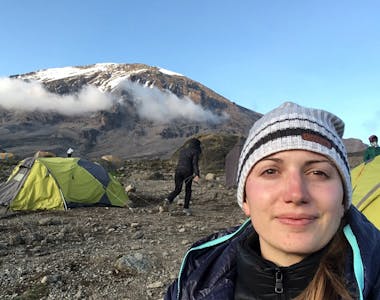
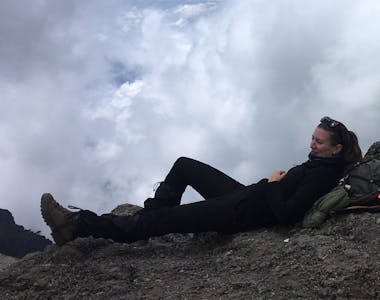
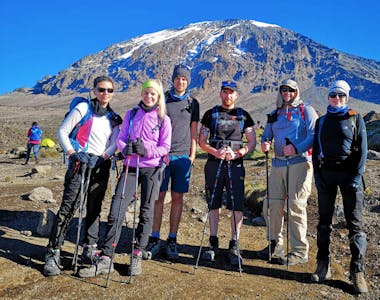
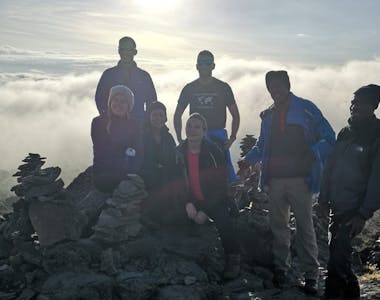

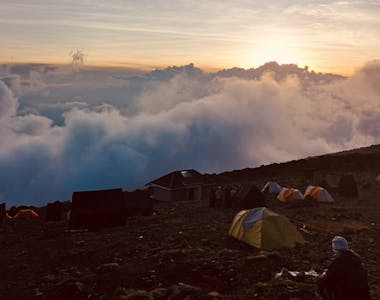
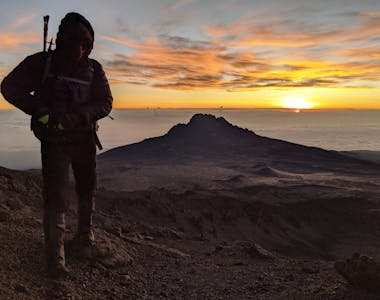
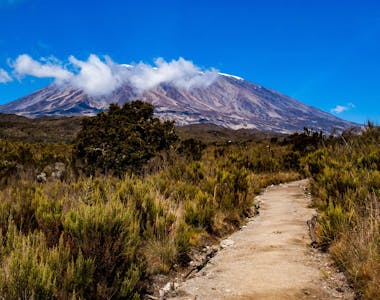
Kilimanjaro Trek Highlights
Book With Confidence
Monthly Payments
Spread the costs with no interest or additional fees
Best Price Guarantee
We won't be beaten on price. If you find this adventure at a lower price please get in touch!
Reserve now & pay later
Reserve your adventure today and pay later, free of charge
ATOL protected
Book with confidence
Hold your space today, for free
or book your trip with a deposit and then pay the rest in instalments.
Reserve your flights with us
Add flights to your booking and we'll take care of the rest. You'll get 24/7 support from our team & ATOL protection.
Speak to our experts
Call or email our expert team to find out more and help with ideas and planning.
